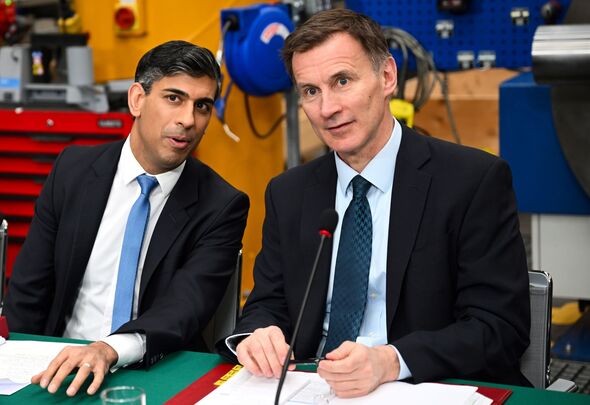Six ‘straightforward’ ways to give yourself a tax cut as burden soars to record high (Image: Getty)
As Britain grapples with its highest tax burden on record, people are being urged to check if they’re using all available tax allowances to make a saving.
The Institute for Fiscal Studies (IFS) found that despite National Insurance cuts in the Autumn Statement, taxes for this fiscal year are expected to be £66 billion higher than if their share of national income had stayed the same as in 2018/19.
Forecasted tax revenue as a proportion of national income is expected to continue increasing, reaching 37.7 percent in 2028/29—the highest level since World War Two.
This translates to an increase of £104billion in today’s terms compared to the 2018/19 figures. The IFS said this was largely “fuelled by freezes to thresholds in the personal direct tax system”.
Irrespective of possible tax cuts in the Chancellor’s upcoming Spring Budget, households can take steps to reduce their tax burden, according to financial planning and tax advisory firm Evelyn Partners.
Britain is grappling with its highest tax burden on record (Image: Getty)
Gary Smith, partner at Evelyn Partners, said: All the talk around tax recently has been of what the Chancellor might announce in his spring Budget on March 6.
“However, even if Jeremy Hunt finds room for some tax cuts, they are unlikely to make much of a dent in the overall tax burden that is rising and due to rise further in the coming years.”
Mr Smith noted: “There are some relatively straightforward steps that everyone can consider taking before the end of the fiscal year on 5 April to streamline their tax efficiency.”
He added: “If earners, savers and investors have not reviewed their tax position in this fiscal year, it’s definitely time to do so now. Many allowances are calculated on a yearly basis, so a pre-tax-year-end review can help to identify any potential tax savings, particularly as some changes are afoot on April 6.”
Reducing taxable income and the 60% tax trap
The highest rate of tax is 45 percent, which from last April has applied to individuals with total income over £125,140.
Personal allowances are tapered for individuals with income between £100,000 and £125,140, which means the marginal tax rate in this band is 60 percent.
Mr Smith said: “There are some relatively easy steps you can take to reduce taxable income, and that can be particularly tax efficient if you are about to or have just fallen into this 60 percent marginal tax rate band.”
These include:
- Making pension contributions or charitable gift aid payments
- Transferring income-generating assets between spouses/civil partners
- Using tax-free investments and/or tax-efficient investments
- Investing in assets which generate capital growth rather than income
- Altering the timing of income to maximise the use of lower rate band.
Pension contributions are typically the “most powerful way” of saving for retirement (Image: Getty)
Pension contributions – using annual allowances
According to Mr Smith, pension contributions are typically the “most powerful way” of saving for retirement – with tax relief given at an earner’s marginal rate of income tax – but are also increasingly a tool for overall tax efficiency.
Mr Smith said: “As millions of people are drawn into higher tax bands and paying tax on more of their income, increasing pension contributions is one of the few ways to mitigate against this and keep more of one’s income. This benefit is accentuated in salary sacrifice payroll systems that also afford relief against National Insurance contributions.”
The pensions annual allowance, which is the maximum amount someone can save into a pension with tax relief, has increased to £60,000 from £40,000 since Jeremy Hunt‘s last Budget.
If a person’s annual ‘net relevant earnings’ are less than £60,000, that sets the limit for tax-relieved contributions in a tax year.
However, it should be noted that higher earners have a tapered annual allowance. If their “threshold income” is over £200,000 and “adjusted income” is over £260,000, their annual allowance decreases gradually to a minimum of £10,000.
Mr Smith noted that people may also be able to take advantage of any unused annual allowance from the previous three tax years to make additional pension contributions under the “carry forward” rules. However, the total amount a person pays in one tax year can still not exceed net relevant earnings.
Mr Smith said: “Raising pension contributions is rarely going to be a disadvantageous move for most people, so some savers might decide they want to take advantage of these reliefs – and the higher annual allowance – while they are available.”
Tax on savings income – sharing with spouse
According to Mr Smith, some people may have a starting rate band of £5,000 for savings income and £1,000 for dividend income, depending on their total income level. However, the dividend income band will reduce to £500 on April 6. Income from savings and dividends within these bands is taxed at zero percent.
Separate from the starting rate savings band, a personal savings allowance is available to basic and higher rate taxpayers – but not to additional rate taxpayers. The allowance is £1,000 per year for basic rate taxpayers and £500 per year for higher rate taxpayers.
Mr Smith said: “Spouses and civil partners should review who holds any savings that generate taxable income to ensure these allowances and rate bands are utilised efficiently.
“You should be aware though that the dividend allowance halves to £500 from April 6, so business owners or partners who have control over when and how dividends are paid might want to make sure they have used up this year’s allowance.”
Making use of tax-free or tax-efficient investments
There are various tax-free and tax-efficient investments available, such as ISAs of National Savings.
People can save up to £20,000 in an ISA tax-free per year, but this limit cannot be carried forward if not used. Mr Smith said: “You can also consider Junior ISAs for children under 18, for which there is a separate annual allowance of £9,000.
“Normally, income arising on funds given to children by a parent remains taxable on that parent if over £100 a year. As ISA income is not taxable. This allows you to give cash to your children without having to pay tax on the income generated.”
Capital gains tax – it’s all about the timing
As capital gains tax is charged when an asset is sold, people have some control over when to pay it. Mr Smith said: “If you have unrealised gains, you may find it beneficial to sell enough assets each year to use your CGT annual exemption, which is £6,000 in this tax year.
He added: “Assets can also be transferred between spouses free of tax, which can help to use up both spouses’ annual exemptions and any capital losses.
The capital gains tax annual exempt amount will halve again to £3,000 from April 2024, which is less than a quarter of the £12,300 that was available as recently as the 2022/23 tax year.
Mr Smith said: “The further imminent drop in the CGT allowance could be an incentive to accelerate gains if you have unused allowance in the current tax year, as planning around the annual exempt amount will become more difficult.”
Inheritance tax – make use of reliefs
Finally, to mitigate a heavy inheritance tax (IHT) bill, gifts made to other individuals are generally not subject to IHT unless the person dies within seven years.
There is also an annual gift allowance of up to £3,000 per tax year, and this will not be subject to IHT even if the person dies within seven years. Mr Smith explained: “This £3,000 annual allowance can only be brought forward for one tax year, so if you have assets to spare you may want to consider using up this and last year’s allowance before April 5.”
The current year’s allowance is automatically used first. It is per donor, not per recipient, so a married couple can make gifts independently.
Mr Smith said: “With the nil-rate band for IHT frozen at £325,000 for 15 years and due to remain so – surprise Budget measures notwithstanding – even those with relatively modest estates might want to look at ways of minimising a future IHT bill. Gifting is one way to do that, and so is paying more into a defined contribution pension, as these are treated very favourably by IHT rules.”













